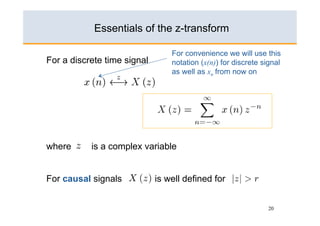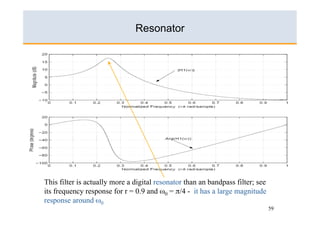Ad
Basics of Digital Filters
- 1. Basics of Digital Filters Elena Punskaya www-sigproc.eng.cam.ac.uk/~op205 Some material adapted from courses by Prof. Simon Godsill, Dr. Arnaud Doucet, Dr. Malcolm Macleod and Prof. Peter Rayner 1
- 2. What is a Digital Filter? Digital Filter: numerical procedure or algorithm that transforms a given sequence of numbers into a second sequence that has some more desirable properties. Input sequence Output sequence xn Digital Filter yn 2
- 3. Desired features Desired features depend on the application, for example Input Signal Output generated by sensing having less noise or device (microphone) interferences speech with reduced redundancy for more efficient transmission 3
- 4. Examples of filtering operations Noise suppression • received radio signals • signals received by image sensors (TV, infrared imaging devices) • electrical signals measured from human body (brain heart, neurological signals) • signals recorded on analog media such as analog magnetic tapes 4
- 5. Examples of filtering operations Enhancement of selected frequency ranges • treble and bass control or graphic equalizers increase sound level and high and low level frequencies to compensate for the lower sensitivity of the ear at those frequencies or for special sound effects • enhancement of edges in images improve recognition of object (by human or computer) edge – a sharp transition in the image brightness, sharp transitions in a signal (from Fourier theory) appear as high-frequency components which can be amplified 5
- 6. Examples of filtering operations Bandwidth limiting • means of aliasing prevention in sampling • communication radio or TV signal transmitted over specific channel has to have a limited bandwidth to prevent interference with neighbouring channels frequency components outside the permitted band are attenuated below a specific power level 6
- 7. Examples of filtering operations Specific operations • differentiation • integration • Hilbert transform These operations can be approximated by digital filters operating on the sampled input signal 7
- 8. Linear time-invariant (LTI) digital filters. We limit ourselves to LTI digital filters only. Time-invariant: xn LTI yn xn-k LTI yn-k Linear: defined by the principle of linear superposition xn1 LTI yn1 xn2 LTI yn2 scaling & additivity properties a1xn1+ a2xn2 LTI a1yn1+ a2yn2 If linear system's parameters are constant it is Linear Time Invariant 8
- 9. Analysis We analyse DSP algorithms by determining: • their time-domain characteristics – linear difference equations – filter’s unit-sample (impulse) response • their frequency-domain characteristics – more general, Z-transform domain • system transfer function • poles and zeros diagram in the z-plane – Fourier domain • frequency response • spectrum of the signal 9
- 10. First method in time domain: Linear difference equations The linear time-invariant digital filter can then be described by the linear difference equation: where {ak} and {bk} real The order of the filter is the larger of M or N 10
- 11. Elements of a Digital Filter – Adders and Multipliers Adders: x1n + yn=x1n+x2n x2n Multipliers: a xn yn=axn x alternative for multiplier Simple components implemented in the arithmetic logic unit of the computer 11
- 12. Elements of a Digital Filter – Delays Positive delay (“delay”): stores the current value for one sample interval xn Z-1 yn= xn-1 alternative for delay Negative delay (“advance”): allows to look ahead, e.g. image processing xn Z yn= xn+1 Components that allow access to future and past values in the sequence 12
- 13. Example: three-sample averager Three-sample averager: yn=(xn+1+ xn + xn-1)/3 Z 1/3 xn + yn Order: Z-1 number of second-order filter delays & advances needed to Nonrecursive filter – output is a function of only the input sequence implement 13
- 14. Example: first-order recursive filter First-order recursive filter: yn=ayn-1+ xn xn + yn Z-1 a one delay Example of feedback first-order implemented in a digital filter Recursive filter – output is also a function of the previous output 14
- 15. Full set of possible linear operations The operations shown in the slides above are the full set of possible linear operations: • constant delays (by any number of samples) • addition or subtraction of signal paths • multiplication (scaling) of signal paths by constants - (including -1) Any other operations make the system non- linear. 15
- 16. Linear difference equations and digital filter structure • Useful for implementing digital filter structures slightly alternative representation 16
- 17. Second method in time domain: unit-sample response • Input signal is resolved into a weighted sum of elementary signal components, i.e. sum of unit samples or impulses ∞ xn= xk δn-k k=- ∞ • The response of the system to the unit sample sequence is determined δn LTI hn • Taking into account properties of the LTI system, the response of the system to xn is the corresponding sum of weighted outputs ∞ ∞ xn= xk δn-k LTI yn= xk hn-k k=- ∞ k=- ∞ 17
- 18. Linear convolution Linear convolution ∞ yn= xk hn-k k=- ∞ gives the response of the LTI system as a function of the input signal and the unit sample (impulse) response LTI is completely characterized by hn 18
- 19. Causal LTI system Causal system: output at time n depends only on present and past inputs but not on future Impulse response: hn = 0 for n <0 Thus ∞ ∞ Yn = xk hn-k = hk xn-k k=- ∞ k=0 19
- 20. Essentials of the z-transform For convenience we will use this For a discrete time signal notation (x(n)) for discrete signal as well as xn from now on where is a complex variable For causal signals is well defined for 20
- 21. Essentials of the z-transform - convolution Convolution admits a z-transform satisfying where Indeed, 21
- 22. Transfer function of LTI Linear difference equation Now, take z-transforms term by term Rearranging, transfer function of the filter is 22
- 23. FIR and IIR filters Transfer function of the filter is Finite Impulse Response (FIR) Filters: N = 0, no feedback Infinite Impulse Response (IIR) Filters 23
- 24. Poles and Zeros The roots of the numerator polynomial in H(z) are known as the zeros, and the roots of the denominator polynomial as poles. In particular, factorize H(z) top and bottom: 24
- 25. Linear Digital Filter in Matlab Matlab has a filter command for implementation of linear digital filters. Matlab transfer function: The format is y = filter( b, a, x); where b = [b0 b1 b2 ... bM ]; a = [ 1 a1 a2 a3 ... aN ]; So to compute the first P+1 samples of the filter’s impulse response, y = filter( b, a, [1 zeros(1,P)]); Or step response, y = filter( b, a, [ones(1,P)]); 25
- 26. z-transform and DTFT DTFT Similarly, to z-transforms a convolution theorem holds: 26
- 27. Frequency Response of LTI LTI system with impulse response hk ∞ xn LTI yn= hk xn-k k=0 Fourier Transform convolution Fourier transform of hk - frequency response of LTI 27
- 28. Frequency Response of LTI Indeed, let us excite the system with the complex exponential where The response of the system to complex exponential Fourier transform of hk is also in the form of complex exponential but altered by the multiplicative factor 28
- 29. Example Assume where for 0 otherwise Frequency response 2 29
- 30. Frequency Response of LTI By knowing we can determine the response of the system to any sinusoidal input signal, hence it specifies the response of the system in the frequency domain = is called magnitude response of a system is called phase response of a system 30
- 31. Frequency response of LTI Transfer function: Frequency response: ω ω ω ω ω ω ω ω The complex modulus: ω ω ω ω and argument: ω ω ω ω linear phase term sum of the angles from the zeros/poles to 31 circle unit
- 32. Frequency response of LTI Im(z) Suppose we have a system with 2 poles (o) unit circle and 2 zeros (x) X We are going around the unit circle with ω O O -1 1 X 32
- 33. Frequency response of LTI Im(z) Transfer function: unit circle X D1 C2 ω O O -1 1 C1 D2 Frequency response: X C1C2 = D1D2 33
- 34. Frequency response of LTI Im(z) unit circle C1C2 X = D1D2 D1 The magnitude of the frequency response is given by times the product of the distances C2 ω from the zeros to O O divided by the product of the -1 1 distances from the poles to C1 D2 The phase response is given by X the sum of the angles from the zeros to minus the sum of the angles from the poles to plus a linear phase term (M-N) ω 34
- 35. Frequency response of LTI Im(z) Thus when 'is unit circle close to' a pole, the magnitude of the response X rises (resonance). D1 When 'is close C2 to' a zero, the magnitude ω falls (a null). O O -1 1 C1 D2 The phase response – more difficult to get X “intuition”. 35
- 36. Frequency response of filter in Matlab To evaluate the frequency response at n points equally spaced in the normalised frequency range ω=0 to ω= π, Matlab's function freqz is used: freqz(b,a,n); Peak close to pole frequency b=[1 -0.1 -0.56]; a=[1 -0.9 0.81]; freqz(b,a) Troughs at zero frequencies 36 36
- 37. Filtering example Generate a Gaussian random noise sequence: x=randn(100000,1); figure(1), plot(x) freqz(b,a); figure(2), plot(abs(fft(x))) a = [1 -0.99 0.9801]; b = [1, -0.1, -0.56]; y=filter(b,a,x); figure(3), plot(y) Figure(4), plot(abs(fft(y))) Selective amplification of one frequency Use soundsc(x,44100) and soundsc(y,44100) and hear the difference! 37 37
- 38. Filter specification Before a filter is designed and implemented we need to specify its performance requirements. There are four basic filter types: • Low-pass • High-pass • Band-pass • Band-stop Frequency band where signal is passed is passband Frequency band where signal is removed is stopband 38
- 39. Ideal Low-pass Filter • Low-pass: designed to pass low frequencies from zero to a certain cut-off frequency and to block high frequencies Ideal Frequency Response 39
- 40. Ideal High-pass Filter • High-pass: designed to pass high frequencies from a certain cut-off frequency to π and to block low frequencies Ideal Frequency Response 40
- 41. Ideal Band-pass Filter • Band-pass: designed to pass a certain frequency range which does not include zero and to block other frequencies Ideal Frequency Response 41
- 42. Ideal Band-stop Filter • Band-stop: designed to block a certain frequency range which does not include zero and to pass other frequencies Ideal Frequency Response 42
- 43. Ideal Filters – Magnitude Response Ideal Filters are usually such that they admit a gain of 1 in a given passband (where signal is passed) and 0 in their stopband (where signal is removed). 43
- 44. Ideal Filters – Phase Response Another important characteristics is related to the phase Ideal filter: admits a linear phase response Indeed, Fourier Transform of delay 44
- 45. Ideal Filters – Linear Phase Response Important property: all frequencies suffer from the same delays In some applications it is critical for this property to hold (at least approximately) 45
- 46. Linear / non-linear phase response phase distortion 46
- 47. Ideal Filters – Linear Phase Response The derivative of the phase/signal respect with respect to ω is known as group delay of the filter - effectively time delay of the frequency when the phase admits a linear phase response group delay is constant 47
- 48. Designing Ideal Filters is Impossible 48
- 49. Ideal Low- pass Filter Example 49
- 50. Filter Design Let’s have a go … 50
- 51. Frequency response of LTI Remember? Im(z) Thus when 'is unit circle close to' a pole, the magnitude of the response X rises (resonance). D1 When 'is close C2 to' a zero, the magnitude ω falls (a null). O O -1 1 C1 D2 The phase response – more difficult to get X “intuition”. 51
- 52. Approximate filter design – rough guidelines A few rough guidelines to start with: • One needs to put the poles within the unit circle to ensure stability 52
- 53. Approximate Low-pass filter Rule 1: The closer to a pole, the higher the magnitude of the response Rule 2: The closer to a zero, the lower the magnitude of the response 53
- 54. Approximate Low-pass filter one pole with added zero 54
- 55. Approximate High-pass filter one can simply reflect We had for Low-pass the poles-zeros locations of the lowpass filter about the imaginary axis 55
- 56. Approximate High-pass filter 56
- 57. Alternative way: Low-pass to High-pass in time domain 57
- 58. Bandpass and Resonator a filter which has its centre of the passband at ω0 58
- 59. Resonator This filter is actually more a digital resonator than an bandpass filter; see its frequency response for r = 0.9 and ω0 = π/4 - it has a large magnitude response around ω0 59
- 60. Band-pass Filter 60
- 61. Band-pass Filter frequency response for r = 0.9 and ω0 = π/4 61
- 62. Notch Filter a filter that contains one or several deeps/ notches in its frequency response to eliminate ω0 Frequencies around the desired null are also seriously attenuated 62
- 63. Notch Filter Frequencies around seriously attenuated with added pair of poles pair of zeros only 63
- 64. All pass Filter Used as phase equalizer 64
- 65. Inverse Filter The zeros become poles and the poles become zeros 65
- 66. Digital Filter Design Considerations Four steps: 1. Specification of the filter’s response (very important! - senior engineers) 3. Design the transfer function of the filter (main goal: meet spec with minimum complexity, often = minimum order) 5. Verification of the filter’s performance • analytic means • simulations • testing with real data if possible 4. Implementation by hardware / software (or both) 66
- 67. Approximate filter design Given precise specification what would you do?? 67
























![Linear Digital Filter in Matlab
Matlab has a filter command for implementation of linear digital filters.
Matlab transfer function:
The format is
y = filter( b, a, x);
where
b = [b0 b1 b2 ... bM ]; a = [ 1 a1 a2 a3 ... aN ];
So to compute the first P+1 samples of the filter’s impulse response,
y = filter( b, a, [1 zeros(1,P)]);
Or step response,
y = filter( b, a, [ones(1,P)]);
25](https://image.slidesharecdn.com/3f34basicsofdigitalfilters-1233218263840435-1/85/Basics-of-Digital-Filters-25-320.jpg)










![Frequency response of filter in Matlab
To evaluate the frequency response at n points equally spaced in
the normalised frequency range ω=0 to ω= π, Matlab's function
freqz is used:
freqz(b,a,n);
Peak close to pole frequency
b=[1 -0.1 -0.56];
a=[1 -0.9 0.81];
freqz(b,a)
Troughs at zero frequencies
36 36](https://image.slidesharecdn.com/3f34basicsofdigitalfilters-1233218263840435-1/85/Basics-of-Digital-Filters-36-320.jpg)
![Filtering example
Generate a Gaussian random noise sequence:
x=randn(100000,1);
figure(1), plot(x) freqz(b,a);
figure(2), plot(abs(fft(x)))
a = [1 -0.99 0.9801];
b = [1, -0.1, -0.56];
y=filter(b,a,x);
figure(3), plot(y)
Figure(4), plot(abs(fft(y)))
Selective amplification
of one frequency
Use soundsc(x,44100)
and soundsc(y,44100)
and hear the difference! 37 37](https://image.slidesharecdn.com/3f34basicsofdigitalfilters-1233218263840435-1/85/Basics-of-Digital-Filters-37-320.jpg)

































































































